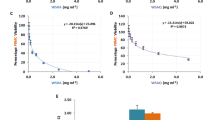Abstract
Objective
To test the anti-human immunodeficiency virus (HIV) activity of pure compounds isolated from aerial part extracts of Alhaji maurorum and its parasite Cuscuta kotchiana.
Methods
The anti-HIV-1 and anti-HIV-2 activities of these extracts were performed by use of quantitative polymerase chain reaction assay and high pure viral nucleic acid kit. The most active fractions against HIV-1 were detected by nuclear magnetic resonance as pratensein and pratensein glycoside respectively in A. maurorum and C. campestris.
Results
These two extracts have low toxicity on HIV-2 replication. The 50% effective concentration for HIV-1 replication of pratensein and pratensein glycoside were 100 and 22 μg/mL, respectively. The time of addition assay showed that pratensein and pratensein glycoside were most effective when added at the early stage (0–4 h) of virus replication.
Conclusion
The pratensein glycoside inhibits HIV-1 replication in host cells more than pratensein and both extracts are potent inhibitors of HIV-1 entry.
Similar content being viewed by others
References
Buonaguro L, Tornesello ML, Buonaguro FM. Human immunodeficiency virus type 1 subtype distribution in the worldwide epidemic: pathogenetic and therapeutic implications. J Viro 2007;81:872–907.
Vermani K, Garg S. Herbal medicines for sexually transmitted diseases and AIDS. J Ethnopharmacol 2002;80:49–66.
Rates SMK. Plants as source of drugs. Toxicon 2001;39:603–613.
Singh P, Bharate S, Bhutani KK. Anti-HIV natural products. Curr Sci 2005;89:269–291.
Wang RR, Yang LM, Chen JJ, Zheng YTJ. Anti-HIV-1 activities of extracts from the medical plant Rhus chinensis. Ethnopharma 2006;105:269–273.
Cos P, Vanden BD, Bruyene TD, Vlietinck A. Plant substances as antiviral agents an update (1997–2001). Curr Org Chem 2003;7:1163–1180.
De Clercq E. Anti-HIV drugs 25 compounds approved within 25 years after the discovery of HIV. Int J Antimic Agents 2009;33:307–320.
Alqasoumi SI, Rehaily AJ, Sheikh AM, Abdel-Kader MS. Evaluation of the hepatoprotective effect of Ephedra foliate, Alhagi maurorum, Capsella bursa-pastoris and Hibiscus sabdariffa against experimentally induced liver injury in rats. Nat Prod Sci 2008;14:95–99.
Behbahani M. Evaluation of in vitro anticancer activity of Ocimum Basilicum, Alhagi Maurorum, Calendula Officinalis and their parasite Cuscuta Campestris. PLoS One 2014;9:e116049.
Laghari AH, Ali Memon A, Memon S, Nelofar A, Khan KM. Determination of free phenolic acids and antioxidant capacity of methanolic extracts obtained from leaves and flowers of camel thorn (Alhagi maurorum). Nat Prod Res 2012;26:173–176.
Browicz K, ed. Chorology of trees and shrubs in South-West Asia and adjacent regions. Warsaw: Polish Scientific Publishers; 1982:186–213.
Shen H, Ye WH, Hong L, Cao HL, Wang ZM. Influence of the obligate parasite Cuscuta campestris on growth and biomass allocation of its host Mikania micrantha. J Exp Bot 2005;56:1277–1284.
Dong-Mei L, Christian S, Shun ZY, Shao-Lin P. Identification of genes differentially expressed in Mikania micrantha during Cuscuta campestris infection by suppression subtractive hybridization. J Plant Physiol 2009;166:1435–1442.
Behbahani M, Mohabatkar H, Soltani M. Anti-HIV-1 activities of aerial parts of Ocimum basilicum and its parasite Cuscuta campestris. J Antivir Antiretrovir 2013;5:57–61.
David M, Morgan L. Tetrazolium (MTT) assay for cellular viability and activity. Methods Mol Biol 1998;79:179–184.
Tao J, Hu QX, Yang J, Li RR, Li XY, Lu CP, et al. In vitro anti-HIV and-HSV activity and safety of sodium rutin sulfate as a microbicide candidate. Antiviral Res 2007;75:227–233.
Rouet F, Ekouevi DK, Chaix ML, Burgard M, Inwoley A, Tony TD. Transfer and evaluation of an automated, lowcost real-time reverse transcription-PCR test for diagnosis and monitoring of human immunodeficiency virus type 1 Infection in a West African resource-limited setting. J Clin Microbiol 2005;43:2709–2717.
Legoff J, Bouhlal H, Grésenguet G. Real-time PCR quantification of genital shedding of herpes simplex virus (HSV) and human immunodeficiency virus (HIV) in women coinfected with HSV and HIV. J Clin Microbiol 2006;44:423–432.
Jadhav RB, Anarthe SJ, Surana SJ, Gokhale SB. Hosthemiparasite transfer of the C-glucosyl xanthone mangiferin between Mangifera indica and Dendrophthoe falcata. J Plant Interact 2005;1:171–177.
Du XM, Kyoko K, Toshio K, Yong-Tian G, Kazumoto M. Components of the ether-insoluble resin glycoside-like fraction from Cuscuta hinensis. Phytochem 1998;48:843–850.
Wong E. Synthesis of pratensein, 5,7,3'-trihydroxy-4'-methoxyisoflavone. Tetrahedron Lett 1963;3:159–161.
Chen HQ, Wang XJ, Jin ZY, Xu XM, Zhao JW, Xie ZJ. Protective effect of isoflavones from Trifolium pratense on dopaminergic neurons. Neurosci Res 2008;62:123–130.
Behbahani M. Anti-HIV-1 activity of eight monofloral Iranian honey types. PLoS One 2014;9:e108195.
Author information
Authors and Affiliations
Corresponding author
Additional information
Supported by the University of Isfahan, Iran
Rights and permissions
About this article
Cite this article
Behbahani, M. Anti-human immunodeficiency virus-1 activities of pratensein and pratensein glycoside from Alhaji maurorum and its parasite Cuscuta kotchiana . Chin. J. Integr. Med. (2017). https://doi.org/10.1007/s11655-017-2820-2
Received:
Published:
DOI: https://doi.org/10.1007/s11655-017-2820-2




